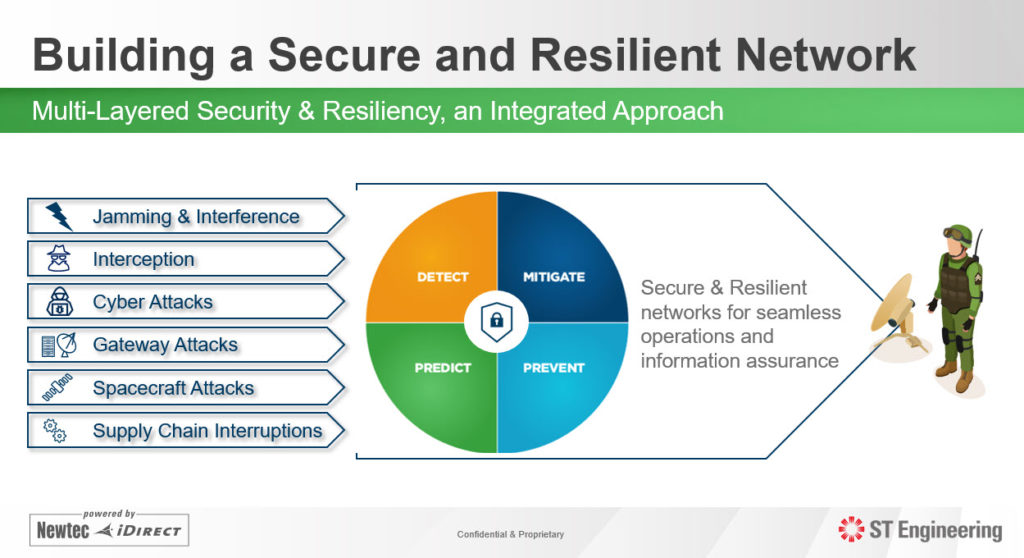Increasingly complex. More dispersed. But still secure and resilient.
This is the reality of the military networks of today and tomorrow. The military market poses multiple challenges when it comes to connectivity and it is a major user of satellite communications due to its multi-faceted operational environments. The big question is whether emerging, next-generation technology provided by the commercial sector is fully aligned with the demands of military satellite networks – or are they moving further apart?
The next generation of space technology, or Space 2.0, comprises of a plethora of benefits for military users such as instant situational awareness, real time intelligence and the agility to change networks and tactics to the situation at hand. These are all key to obtaining strategic and operational advantage. Warfighters are becoming increasingly connected through sensor and camera technology, so that the status of all troops is known. And it’s not just the warfighters that are connected. Assets in the field are also networked so that they may be easily monitored, and any issues flagged up and dealt with to keep all the moving parts working in synergy. A holistic picture is essential for greater command and control resulting in faster, more accurate decision making.
“The next generation of space technology, or Space 2.0, comprises of a plethora of benefits for military users…”
However, with all of this data continuously flowing, a high amount of capability from satellite networks is called for. The commercial satellite community is working hard to ensure that this data can be exchanged as efficiently as possible no matter whether it is voice, data, video or imagery. High Throughput Satellites (HTS) in multiple orbits, the Military Internet of Things (IoT), M2M, 5G and also edge computing, where exchanging and processing of local data may be facilitated without passing on to a central hub, are all coming together to enable a high-tech combat force. These new services and technologies must all be orchestrated, and resources allocated in a flexible, agile and secure way in order to gain the desired outcome – an operational advantage over the adversary.
To achieve this, security and resiliency of the networks is essential and this can be realized through a fully integrated approach, encompassing multiple layers of security and resiliency to facilitate seamless operation, maximum end-user experience and information assurance. This is built on 4 key pillars:
1. DETECT:
The ability to detect a threat within a network is an essential requirement. This involves a set of tools, like the ones provided by ST Engineering iDirect. Combined with network monitoring embedded in our VSAT platforms, we also offer spectrum monitoring and geolocation so that incidents may be detected and resolved as quickly as possible.
2. MITIGATE:
Threats such as jamming and interference are tackled rapidly through the integration of interference excision technology in modems and through built-in satellite redundancy and network diversity in network architecture. Excision technology such as our CISR tool dynamically filters or cuts away different types of interference or jammers. If the interference or jamming becomes severe, the ability for the modem in the field to automatically switch from one satellite to the other is a key advantage. The key here is that several networks can be part of a single platform to ensure persistent connectivity.
3. PREVENT:
Though detection and mitigation are both essential, the ability to prevent adversaries from listening to your traffic and stealing information or blocking operations is also a key consideration. The full implementation of TRANSEC is available on our Evolution Defense platform on both traditional two-way and one-way broadcast networks where intelligence is being sent to different assets in operation. Next to the satellite link the satellite network itself needs protection against the increasing number of cyber threats. While training and awareness can help prevent some cyber-attacks, software code on hubs, modems and network elements require updates on a regular interval to ensure that the latest threats are addressed.
4. PREDICT:
Finally, you must have the tools and methodologies to be able to proactively counter any threats. Prevention can be achieved through the planning and organization of your space, ground and network assets so that your operations are supported in the right way. We provide a tool called SAMS, a link budget and planning tool optimized for both fixed and on-the-move applications and that works closely together with the spectrum monitoring functionalities.
“…an integrated approach and a mix of technologies that work together in a multi-layered security and resilient network enables militaries and government users to achieve seamless operations and information assurance.”
Unifying an integrated approach and a mix of technologies that work together in a multi-layered security and resilient network enables militaries and government users to achieve seamless operations and information assurance. ST Engineering iDirect incorporates this approach within its technology offering to our military customers. As to whether the commercial sector is fully aligned with the demands of military satellite networks, it is clear that commercial satcom can both meet and exceed the military’s requirements for security, resiliency and flexibility.
Now it’s your turn to discover more about our multi-layered approach. We have some insightful materials available that will take you through the ways in which ST Engineering iDirect can help you gain the operational advantage.
Read the whitepaper, ‘Gaining Operational Advantage Through Innovative Satcom Networks’ and watch our webinar, ‘Build to Protect with Secure and Resilient Military Networks’ on demand.

